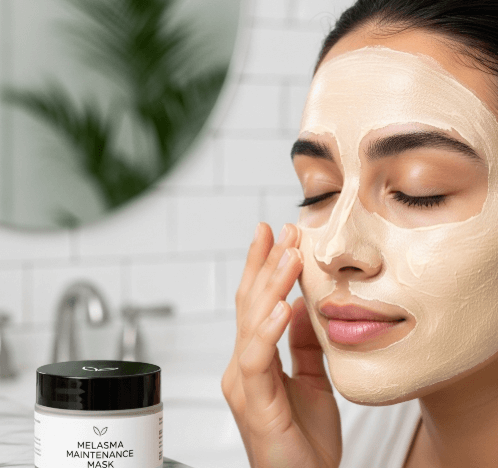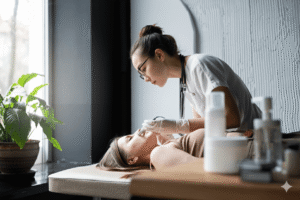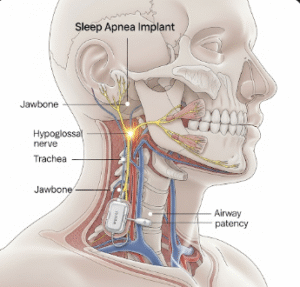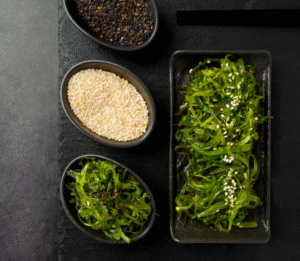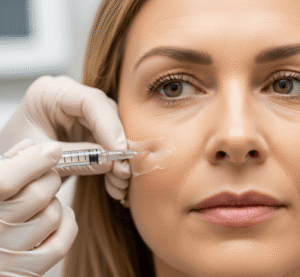What it is
→ A melasma maintenance mask is a medical-grade or dermatology-formulated skincare treatment designed to control pigmentation and prevent recurrence of melasma after initial depigmentation therapy (such as Cosmelan, Dermamelan, Enlighten peel, or laser toning).
→ Melasma is a chronic condition influenced by hormones, sun exposure, and skin sensitivity. Even after successful treatments, pigmentation often returns without proper maintenance.
→ The maintenance mask works by combining melanin-inhibiting ingredients, exfoliants, and antioxidants that suppress pigment formation while supporting skin renewal.
→ In Korea, these masks are part of long-term pigmentation care programs, customized by dermatologists for ongoing home use.
Why it’s done
→ Melasma maintenance masks are used to:
- Prevent relapse of melasma after clinical treatment.
- Suppress melanin production by inhibiting tyrosinase (the pigment-forming enzyme).
- Lighten residual pigmentation left after peels or lasers.
- Maintain bright, even skin tone long-term.
- Reduce skin inflammation and oxidative stress, which trigger pigment formation.
→ Without a maintenance plan, melasma often returns within 3–12 months.
Alternatives
→ Alternatives to a melasma maintenance mask include:
- Topical creams (hydroquinone, azelaic acid, retinoids, tranexamic acid, vitamin C).
- Oral medications (tranexamic acid, antioxidants).
- Regular laser toning sessions (Q-switched Nd:YAG or picosecond lasers).
- Pigmentation cocktail peels every few months.
- Strict sun protection with daily SPF 50+.
→ However, maintenance masks offer a convenient, at-home solution to prolong clinic results.
Preparation
→ Before starting a melasma maintenance mask:
- Complete initial treatment (Cosmelan, Dermamelan, Enlighten, or laser).
- Allow recovery period → wait until peeling and irritation from initial treatment have subsided.
- Consult dermatologist → masks are usually prescribed as part of a structured aftercare program.
- Discontinue harsh skincare (AHAs, BHAs, strong retinoids) unless directed by the clinic.
- Ensure consistent sunscreen use, as no maintenance mask can prevent pigmentation without UV protection.
How it’s Done
→ A typical melasma maintenance mask protocol includes:
- Application frequency
- Initially applied once daily or every other day, depending on skin tolerance.
- Frequency is gradually reduced to 2–3 times per week for long-term use.
- Method
- Skin is cleansed and dried.
- A thin layer of the mask is applied evenly to the face or affected areas.
- Left on for overnight treatment or washed off after 20–30 minutes, depending on product strength.
- Active ingredients may include:
- Azelaic acid → anti-inflammatory, pigment suppressor.
- Kojic acid → inhibits melanin production.
- Arbutin → natural skin brightener.
- Tranexamic acid → blocks vascular pathways in melasma.
- Retinoids → stimulate skin renewal and enhance penetration.
- Niacinamide → reduces pigment transfer between skin cells.
- Vitamin C & antioxidants → brighten and protect skin.
→ Korean dermatologists often prescribe Dermamelan Maintenance Mask or custom-blended formulas tailored to patient needs.
Recovery
→ Maintenance masks are gentle compared to initial peels, so downtime is minimal:
- Mild redness, dryness, or tingling may occur initially.
- Flaking or peeling is possible during the first weeks of use.
- Skin tone gradually evens over weeks to months with consistent use.
→ Patients should:
- Use hydrating serums and moisturizers to balance dryness.
- Avoid combining with harsh exfoliants unless recommended.
- Always wear SPF 50+ sunscreen daily to protect results.
Complications
→ While safe, possible side effects include:
- Irritation, dryness, or peeling in sensitive skin.
- Increased sensitivity to sunlight if sunscreen is not used.
- Hypopigmentation if overused or misapplied.
- Allergic reaction to certain ingredients (rare).
→ These risks are minimized by dermatologist monitoring and proper usage schedules.
Treatment options in Korea
→ Korea offers some of the most advanced melasma maintenance programs, often centered around prescription masks:
- Dermamelan Maintenance Mask → globally recognized system available in Korean dermatology clinics.
- Custom-blended formulas → dermatologists create masks with specific concentrations of tranexamic acid, retinoids, and brightening agents.
- Integrated skincare packages → maintenance masks are paired with soothing gels, brightening serums, and sunscreen.
- Combination therapy → often used alongside laser toning or oral tranexamic acid for maximum control.
- Long-term care focus → Korean clinics emphasize sustained results, not quick fixes, ensuring melasma stays suppressed.
- Medical tourism options → international patients are provided with detailed at-home instructions and product refills.
→ With medical-grade formulations, advanced pigmentation expertise, and holistic aftercare, Korea is one of the best destinations for melasma management and long-term maintenance.

